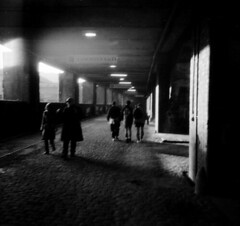 Everybody loves the Monroe lines of a classic scooter, most famously those of the GS model. Among the last of the curvaceous largeframes was the Rally, and the Sprint Veloce (my own beloved example 'Bella' is pictured here on a visit to North Weald Aerodrome), phased out with the introduction of the distinctly chunky P Range, from 1977. The P Range was the last manually-geared Italian scooter and continued in production until it was taken round the back of the EU Emissions office and shot by The Man in 2007. The Vespa range nowadays is a line up of excellent automatic transmission future-retro scoots, most of which take their styling cues from the Vespa's sixties heyday. Given the numbers that they sell, there's a huge demand for stylish retro scooters.
Everybody loves the Monroe lines of a classic scooter, most famously those of the GS model. Among the last of the curvaceous largeframes was the Rally, and the Sprint Veloce (my own beloved example 'Bella' is pictured here on a visit to North Weald Aerodrome), phased out with the introduction of the distinctly chunky P Range, from 1977. The P Range was the last manually-geared Italian scooter and continued in production until it was taken round the back of the EU Emissions office and shot by The Man in 2007. The Vespa range nowadays is a line up of excellent automatic transmission future-retro scoots, most of which take their styling cues from the Vespa's sixties heyday. Given the numbers that they sell, there's a huge demand for stylish retro scooters.In the last 15 years or so there have been several pretenders to the Vespa's curvy crown. Notably there's been the very decent Aprilia Habana ridden by Jamie Oliver and the Italjet Velocifero. The Velocifero was much loved by the likes of Oasis at the height of Britpop but suffered from spares availability of almost zero and comically priced accessories. Passenger seat pad? That'll be £100. Get a few scooterists down the pub, and sooner or later someone will ask why nobody's producing a GS replica with a modern engine in it. It seems so obvious. Well, now someone has.

 This here scoot is apparently the prototype 'Venti', a project by an American company which specialises in Chinese-made off road vehicles. It's clearly heavily influenced by the GS. According to 2strokebuzz it's a plastic body over a tubular frame, rather than the steel monocoque the Vespa is famous for. It certainly looks the part, or will with a few modifications. There's some speculation that the automatic motor is a 150cc unit, either Indian or Chinese. The Venti was on show at the Indianapolis Motorcycle Show this month, so it looks like it might actually be a goer, unlike the 'new' Lambretta rumours that were knocking around a couple of years back. There are at least four companies that claim to own the trademark for Lambretta (quite apart from the clothing company of the same name) two of which have launched scooters. Both of these turned out not to be the beautiful near-replicas promised by teaser images, but bog-standard far eastern auto mopeds rebadged with the famous name, like this insult for the American market, or this slightly nicer one for the Italians. Ugh.
This here scoot is apparently the prototype 'Venti', a project by an American company which specialises in Chinese-made off road vehicles. It's clearly heavily influenced by the GS. According to 2strokebuzz it's a plastic body over a tubular frame, rather than the steel monocoque the Vespa is famous for. It certainly looks the part, or will with a few modifications. There's some speculation that the automatic motor is a 150cc unit, either Indian or Chinese. The Venti was on show at the Indianapolis Motorcycle Show this month, so it looks like it might actually be a goer, unlike the 'new' Lambretta rumours that were knocking around a couple of years back. There are at least four companies that claim to own the trademark for Lambretta (quite apart from the clothing company of the same name) two of which have launched scooters. Both of these turned out not to be the beautiful near-replicas promised by teaser images, but bog-standard far eastern auto mopeds rebadged with the famous name, like this insult for the American market, or this slightly nicer one for the Italians. Ugh.














